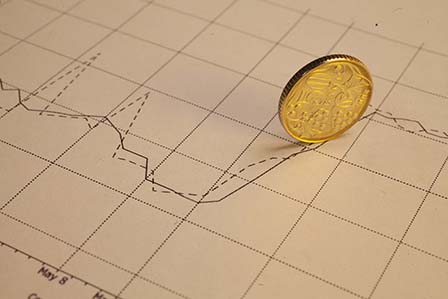In January 2018, the annual inflation rate [1] constituted 6.5 percent, being by 0.8 percentage points lower than in the previous month and reaching the upper limit of the variation range of ± 1.5 percentage points from the 5.0 percent target.
The dynamics of inflation in January 2018 is in line with the latest forecast of the NBM. The evolution was driven by the appreciation trend of the national currency, modest aggregate demand and the effect of a high base period in 2017.
The biggest contribution to the annual inflation rate (3.5 percentage points) was recorded for food products[2]. The core inflation and regulated prices had an impact of 1.6 percentage points and of 1.3 percentage points, respectively, each being by 0.1 percentage points lower than in December 2017. The impact of fuel prices was by 0.1 percentage points below the level of the previous month and constituted 0.2 percentage points.
The monthly inflation rate registered a level of 0.4 percent, mainly being driven by the 0.9 percent increase in food prices. Prices for non-food goods registered a more modest evolution, increasing by 0.2 percent and prices for services decreased by 0.1 percent.
In the reference month, the annual rate of core inflation recorded the value of 5.2 percent, being by 0.3 percentage points lower than in the previous month.
At the same time, the monthly core inflation rate in January constituted 0.1 percent. The most significant price increases were registered for subcomponents: "cigarettes", "education and training", "clothing" and “footwear”.
The increase in food prices by 0.9 percent compared to December 2017 was mainly due to the rise in prices for “fresh fruits” (8.5 percent) and "fresh vegetables" (4.4 percent), "potatoes" (3.1 percent), "fish and canned fish” (0.5 percent), and for "milk and dairy products" (0.4 percent). Excluding the seasonal factor, food prices remained at the level of the previous month. The rise in prices for fresh fruits is a consequence of atypical meteorological conditions in the spring of 2017.
The annual growth rate of food prices constituted 8.4 percent, being by 1.3 percentage points lower than in December 2017 and by 4.6 percentage points higher than in January 2017.
In January 2018, oil prices increased by 1.8 percent compared to the previous month. This development was mainly influenced by the rise in 'fuel' prices by 3.1 percent, generating a contribution of 1.6 percentage points. The fuel price dynamics was the result of prices increases for petrol and diesel prices in line with the oil prices trend on the international market, as well as of the change in the rate of excise duty on petrol and diesel. Prices for "firewood" increased by 0.6 percent, having a minor contribution to the formation of the monthly fuel prices. Prices for "earth coal" and “bottled gas” registered a drop of 0.6 percent and 0.1 percent, respectively. At the same time, the "liquid fuel" prices maintained the level of December 2017.
The annual growth rate of fuel prices in January 2018 constituted 2.7 percent - lower by 2.4 percentage points compared to the previous month and, respectively, by 5.2 percentage points lower compared to January 2017.
During the reference month, prices for regulated services and products recorded a decrease of 0.4 percent, being determined by a decrease of 1.1 percent in electricity tariffs and by the continuing downward trend in medicine prices (1.2 percent).
The annual growth rate of regulated products and services constituted 5.6 percent, lower by 0.5 percentage points compared to the previous month and by 6.9 percentage points higher than in January 2017.
The NBM will monitor the domestic and international economic developments, and will use the operational framework specific for the inflation targeting strategy in order to maintain the medium-term price stability..
[1] Annual inflation rate represents the increase of consumer prices during a month this year compared with the same month last year. It is calculated as a ratio (expressed in percentage terms) between the price index during a month this year and price index during the same month last year, calculated on the same basis, minus 100. Statistical surveys on consumer prices are carried out by the National Bureau of Statistics (NBS). NBM sets its inflation target at the level of 5.0 percent annually, calculated based on the consumer price index (inflation rate for the last twelve months – each month of this year compared with the same month of last year), with a possible deviation of ±1.5 percentage points. (Source: Medium-term monetary policy strategy of the NBM.
[2] According to the calculation methodology of the CPI, the weighting coefficients is changed annually on the basis of the household money expenditure structure according to the Household Budget Survey data in year t-2 adjusted to the final consumption of households in the National Accounts (reference metadata http://www.statistica.md/public/files/Metadate/IPC.pdf). The shift to the new weighting ratios (the share of food prices and the share of basic inflation increased to the detriment of fuel prices and regulated services prices) was made for CPI calculations in January 2018.





















